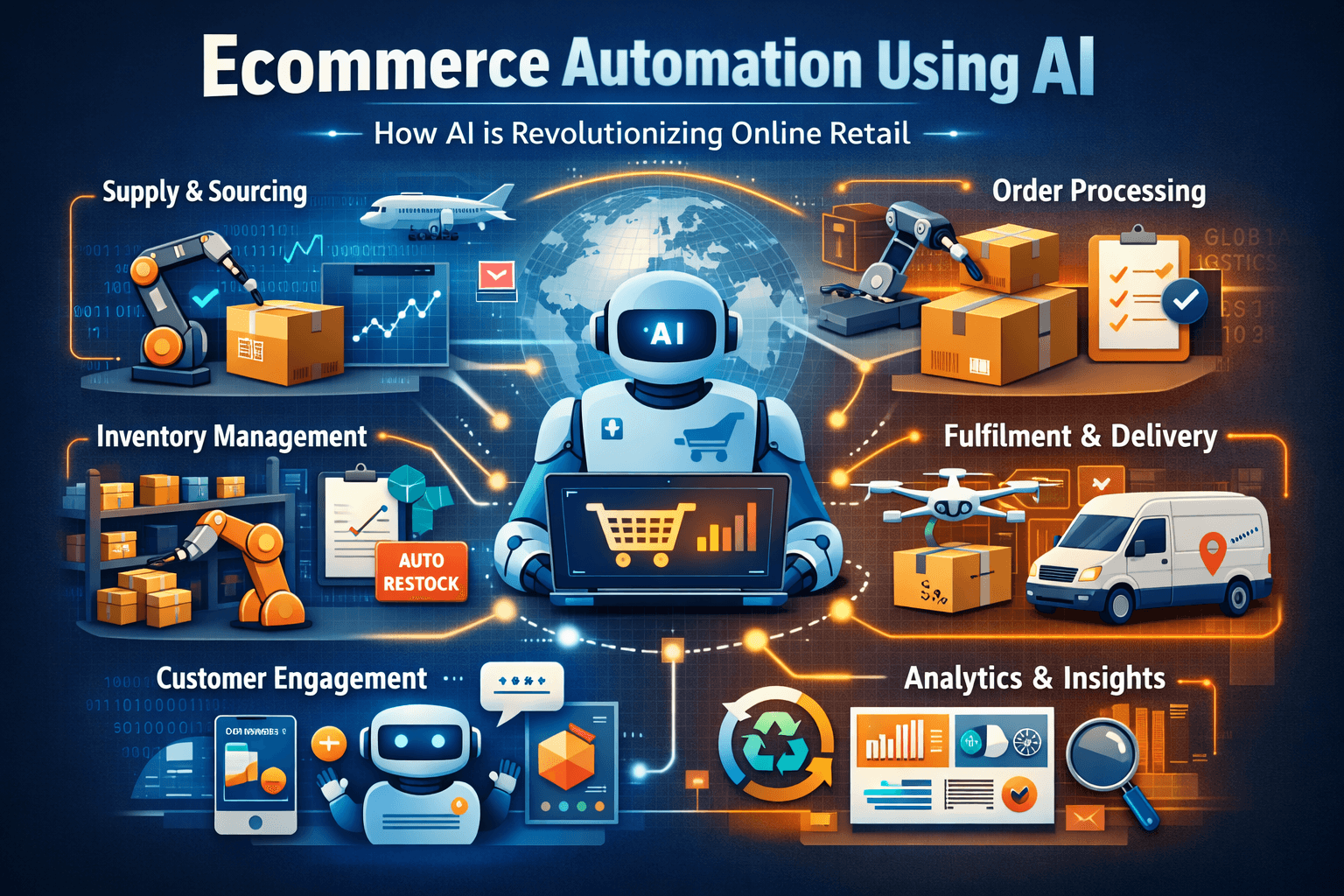How Augmented Reality Retail Shopping Is Changing Fashion?
The Role of AI Shopping Bots in Modern E-commerce


When you’re shopping online, you probably don’t think about who — or what — is helping you behind the screen. But the truth is, more than ever before, your favorite brands rely on AI shopping bots to keep you moving from browsing to buying.
These bots pop up in chat windows, recommend products, help track your orders, and answer simple questions in seconds. It’s fast, smooth, and cost-effective for businesses. But can these digital helpers really replace the warmth and wisdom of a human support team?
In this deep dive, we’ll unpack the world of AI shopping bots — how they evolved, what they do best, where they fall short, and why the smartest brands use them together with real people to keep shoppers happy.
The Journey of AI Shopping Bots: From Scripts to Smart Conversations

Decades ago, “bots” were nothing more than clunky programs following rigid scripts. The first recognizable chatbot, ELIZA, could mimic human conversation with pre-set lines. Useful? Maybe — but not exactly smart.
Fast forward to today, and AI shopping bots have become powerful digital assistants. They rely on Natural Language Processing (NLP) and Machine Learning. They learn from millions of interactions to refine their answers and get better at understanding what customers mean — even when people type in slang, incomplete phrases, or questions that aren’t worded perfectly.
This evolution means that modern AI shopping bots are no longer just answering “What’s my order status?” They’re doing proactive work too — recommending items, reminding customers about abandoned carts, or highlighting deals that match their style.
Why Brands Love AI Shopping Bots: The Big Wins
1️. They’re Always Awake
Unlike human teams that clock out, AI shopping bots are live 24/7, 365 days a year. No holidays. No overtime. Whether it’s a customer shopping at midnight from their couch or browsing during lunch at work — the bot is right there, ready to help.
This round-the-clock support builds trust because customers know they can get help whenever they need it.
2️. They Give Instant Gratification
In the digital world, nobody likes waiting. Shoppers want answers now. Even waiting a few minutes can make them bounce to another site.
AI shopping bots can respond to thousands of chats simultaneously — all in real time. No waiting in line, no elevator music, no hold time.
3️. They Never Get Tired of Repeating Themselves
Some customer questions are asked 100 times a day — “Where’s my order?”, “What’s your return policy?”, “Is this available in my size?” Humans can get drained repeating themselves. Bots don’t.
AI shopping bots thrive on these repetitive, routine queries. They deliver fast, consistent answers every single time, with no attitude and no burnout.
4️. They Can Handle Huge Peaks in Traffic
Black Friday. Flash sales. Limited drops. During these moments, thousands of people can flood an online store at once. A human-only support team might drown in requests.
AI shopping bots scale effortlessly. They can talk to ten people or ten thousand — all at once — with zero drop in response time.
5️. They Make Personalization Feel Effortless
The best AI shopping bots don’t just answer questions — they personalize the whole shopping experience. By analyzing your browsing behavior, purchase history, and what you’ve clicked on, they can recommend products that feel tailor-made for you.
Imagine logging into your favorite store and instantly getting suggestions that match your size, style, and budget — without needing to search. That’s the power of a smart bot.
6️. They’re Cost-Smart for Brands
Hiring and training big support teams is expensive. As a business grows, so does the cost of handling customer questions. AI shopping bots take on the bulk of routine work, so companies can keep support costs manageable while still offering fast service.
This doesn’t just save money — it frees up human agents to tackle higher-value conversations that bots can’t handle.
Why AI Shopping Bots Are Gaining Popularity
E-commerce businesses are increasingly adopting AI shopping bots for a variety of compelling reasons:
- Efficiency and Speed: In an industry where customers demand instant gratification, AI shopping bots offer immediate responses to queries, ensuring that customers don’t have to wait in long queues. This speed is crucial for maintaining a positive customer experience.
- Scalability: AI bots can handle thousands of customer inquiries simultaneously, ensuring that customer support remains uninterrupted even during peak shopping seasons or sales events. This scalability gives e-commerce businesses the ability to serve a global audience without expanding their support teams.
- Cost-Effectiveness: By automating routine tasks, businesses can significantly reduce operational costs. AI bots eliminate the need for large human teams to handle repetitive questions, allowing brands to save money and allocate resources to other areas of their operations.
The Strengths of AI Shopping Bots

AI shopping bots come with a set of unique advantages that make them an attractive solution for e-commerce businesses:
1. 24/7 Availability
AI shopping bots are always available. Whether it’s midnight or Sunday morning, they’re ready to assist customers, answer queries, and guide them through their shopping journey. This round-the-clock availability is essential for serving customers across different time zones and ensuring that no customer feels neglected.
2. Instant Responses
Time is money, especially in the fast-paced e-commerce world. Customers expect quick resolutions to their problems. AI shopping bots can respond to repetitive and simple queries instantly. Whether it’s checking order status, confirming product availability, or explaining return policies, bots can handle it all in a matter of seconds.
3. Scalability
One of the major advantages of AI shopping bots is their ability to handle large volumes of inquiries simultaneously. During peak shopping periods such as Black Friday or Cyber Monday, AI bots can manage thousands of interactions without any delays, while human support teams might struggle to keep up.
4. Data-Driven Personalization
AI bots can analyze vast amounts of data in real time and offer personalized recommendations based on browsing history, past purchases, and even current shopping behavior. This personalization ensures that customers are presented with relevant products, which enhances the overall shopping experience.
5. Cost Efficiency
By automating repetitive tasks like answering common questions, bots significantly reduce the need for large support teams. This leads to cost savings over time, especially for businesses that handle high volumes of customer interactions. The bot's initial setup costs are often outweighed by long-term savings on staff wages and training.
The Human Edge: Where Bots Can’t Compete

Even with all these strengths, AI shopping bots aren’t perfect. Sometimes, only a real person can make the difference between a lost sale and a loyal customer. Here’s why:
1️. People Understand Emotion
Bots are brilliant at processing data but limited when it comes to emotion. If a customer is upset about a delayed shipment or a wrong item, they don’t want canned replies — they want to feel heard.
A human agent can apologize sincerely, read the customer’s tone, and adjust their words to rebuild trust. Bots can try — but it’s never quite the same.
2️. People Think Outside the Box
Most AI shopping bots are rule-based with machine learning. If a problem falls outside those rules, they struggle. Complex refunds, unusual exchanges, or special requests often need a human’s problem-solving skills and judgment.
A real support agent can break policy when needed, escalate a case creatively, or work with other departments to fix things in a way a bot never could.
3️. People Build Real Loyalty
Customers remember great service. A bot might impress with speed, but a warm, helpful human can win hearts. Over time, those human moments build deep trust — which means repeat customers, positive reviews, and word-of-mouth referrals.
4️. People Can Cross-Sell Naturally
While AI shopping bots can recommend products based on data, humans can connect dots bots might miss. Maybe a customer is buying a laptop — a skilled agent might suggest the right case, a matching mouse, or an extended warranty, picking up on clues bots can’t read.
How Do Bots and Humans Stack Up?
Here’s a quick look at how AI shopping bots compare with human support:
Feature | AI Shopping Bots | Human Support |
Availability | 24/7 | Limited hours |
Speed | Instant | Minutes |
Handling Volume | Unlimited | Limited |
Repetition | No burnout | Can fatigue |
Emotional Understanding | Limited | High |
Complex Issues | Limited | High |
Personal Touch | Low | High |
Trust Building | Low | High |
Cost | Lower over time | Higher |
The Winning Formula: Use Both
The truth is, it’s not about bots vs humans — it’s about bots + humans.
Smart brands know the secret: AI shopping bots handle repetitive tasks, track orders, answer FAQs, and recommend products. Human agents focus on special cases, emotions, and turning problems into loyalty moments.
This hybrid approach balances the best of both — bots keep things fast and cheap, while people keep it warm and real.
Future of AI Shopping Bots: What’s Next?
The future for AI shopping bots is bright. Bots are getting better at natural conversation, understanding voice commands, and even reading sentiment. Some can detect if a customer is upset and escalate to a human automatically.
Voice shopping is also booming — bots will soon help you shop by just talking to your phone. And pairing bots with AR (Augmented Reality) is turning virtual try-ons into reality.
But even then, human support won’t vanish. Big purchases, emotional moments, and complex complaints will always need a human touch.
Wrap Up
So — who really makes shopping effortless?
AI shopping bots handle the heavy lifting: speed, volume, 24/7 service, and smart suggestions. They cut costs and keep things moving.
But when it comes to complex problems, emotional support, and building loyalty that lasts, humans are irreplaceable.
The smartest brands already know this secret — use bots for efficiency and humans for empathy. That’s how you turn first-time buyers into lifelong fans.
FAQs
Are shopping bots illegal?
Shopping bots are legal when used responsibly, but they can become illegal if they bypass security systems, violate a site’s terms, or support fraudulent activity. Bots used for unfair buying practices, such as ticket or product scalping, are restricted in many regions. Retailers often block harmful bots to protect customers and maintain fair access.
Is there an AI for shopping?
Yes, there are many AI tools built specifically for online shopping. They act as smart assistants that help you find products, compare options, personalize recommendations, and track orders. These AI systems are now part of major marketplaces, search engines, and retail apps to make shopping faster, easier, and more intuitive for every user.
Do any AI trading bots work?
Some do, especially those using predictive analytics. However, success depends on market conditions and algorithm quality.
What is a shopping bot?
A shopping bot is an automated program that acts like a virtual shopping assistant. It uses AI to help you find products, compare options, answer questions, and guide you through checkout. By handling simple tasks and giving personalized suggestions, it makes online shopping faster, easier, and more intuitive for everyday users.
How does Glance AI help in AI inventory management?
Glance AI targets the right customer segments, helping optimize inventory movement and reduce stock imbalances through user engagement and behavioral insights.






